It's only natural to think of Joint Operations: Typhoon Rising as an attempt to clone EA's successful multiplayer-focused team-based shooters, Battlefield 1942 and Battlefield Vietnam. On the surface, Joint Operations looks like a modern-day Battlefield game: you participate as a member of a team as you attempt to seize a number of strategic objectives, and you can run around on foot or jump into a myriad of vehicles to get around the vast maps. But developer and publisher NovaLogic throws in a lot of new features to differentiate Joint Operations from the competition, and some of these features are quite innovative and exciting. There's the fact that the game can support up to 150 players per server, which is significantly greater than what the Battlefield games can support. Then there's the dynamic day/night cycle that actually models the time of day; no longer are you fighting in perpetual daylight or eternal dusk. Joint Operations is a genuinely exciting game, which makes it all the more difficult to admit that the retail version of the game also has a few notable flaws. 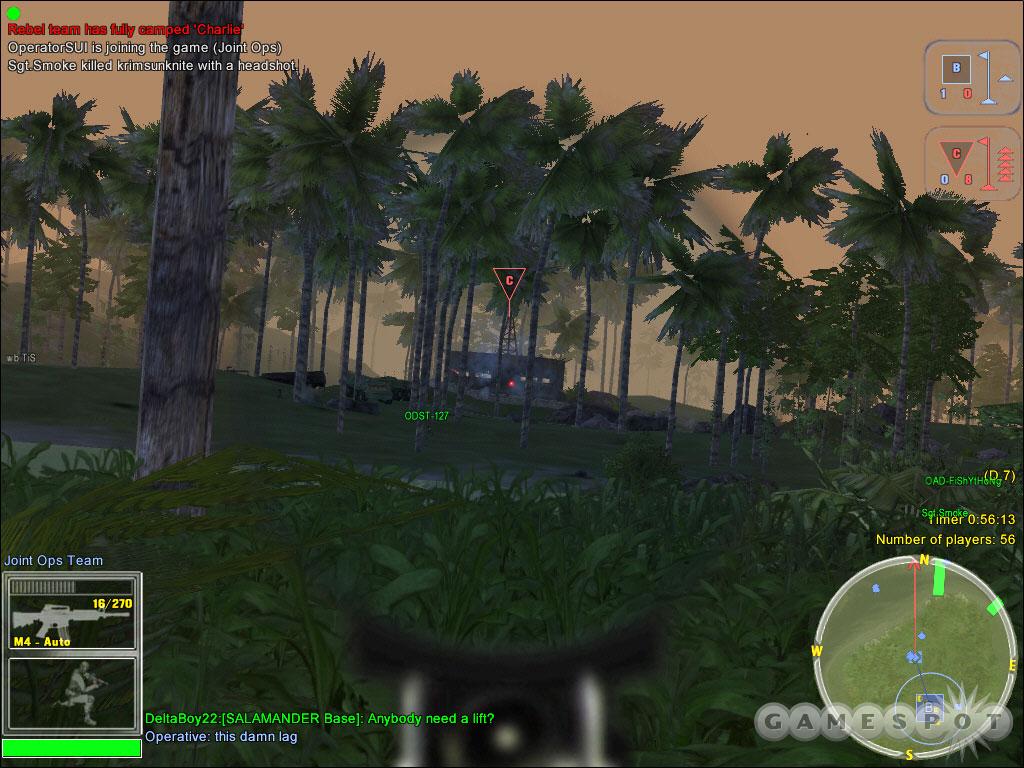
Joint Operations is set in Indonesia, the sprawling archipelago nation that is one of world's largest democracies, but one that's flush with volatile religious and ethnic tensions. After a bloody insurgency erupts, the United States and other Western nations dispatch their special forces to the island. You can play as either a Joint Operations trooper or as a member of the insurgency in a number of multiplayer gameplay modes, including co-op, team deathmatch, team king of the hill, and "advance and secure," which resembles Battlefield's conquest mode where your team has to seize a number of control points on the map in order to win. Unlike Battlefield, there is no single-player option to play the team-versus-team maps with computer-controlled teammates, though the game does allow you to play the co-op missions solo against artificial intelligence bots. We wouldn't recommend trying it solo, though, as the bots possess uncanny marksmanship. Generally, the bots in co-op games are pretty passive--they wait for you to come into detection range before firing on you, so they're a letdown compared with actual human opponents.
As in most team-based shooters, in Joint Ops, you choose a character class to play, each with its own distinct weapons and equipment. The rifleman gets the rocket launcher, which is useful against vehicles, and he can also choose between a variety of assault rifles and grenades. The gunner has access to the heavy machine guns that can lay down suppressive fire. The engineer gets some basic rifle choices, but he can choose between the Stinger antiaircraft missile and the mortar, which can rain down a devastating barrage. The sniper gets the sniper rifles and the target designator; if a sniper designates a target for a mortar-equipped engineer, the mortar fire becomes devastatingly accurate. And then there's the medic class, which can heal teammates and also revive fallen allies on the battlefield. All the classes are designed to complement each other, and a well-balanced team is preferable to a team made up primarily of snipers, for instance.
You can also choose to forgo some of the secondary weapons and tweak your ammunition load in order to lighten your encumbrance. Joint Operations takes into account the amount of weight in weapons and ammunition that you carry, so a lightly encumbered player can run faster than a heavily encumbered one. It's an interesting trade-off, because there are moments in the game when it's useful to be able to run faster than everyone else--to make a sprint for the helicopter, for example--but there are other moments when you'd give your left arm for a Stinger to shoot down a helicopter dogging you, or to have a rocket-propelled grenade knock out the Stryker personnel carrier being used as a floating gun platform near your base.

Once you start playing, the thing that strikes you about Joint Operations is that this is a huge game. There are approximately 30 maps, some measuring the equivalent of 50-square kilometers in size. Even with 150 players in a map, it's still possible to feel alone at times. Thankfully, the game's objective system ensures that the action is concentrated at several strategic points, so it's not just a bunch of players running around haphazardly. When everything is going on in Joint Operations, it's an amazing experience. You'll stand there as helicopters circle around and the buzz of the chain gun can be heard over the thrum of the rotors while a hail of bullets rain down. Meanwhile, mortar rounds scream overhead and bullet tracers fly by your head. Then an armored personnel carrier will roll up and a squad will dismount and scatter into the nearby tall grasses. It would be almost perfect if not for the fact that you die far too easily in this game, which can cause some frustration.
Don't get us wrong, we're not averse to realistic first-person shooters. But the simple fact is that it doesn't take much to kill you in Joint Operations, which may seem surprising given that the game makes any number of other concessions in the interest of being more fun to play at the expense of pure realism. You'll be standing there one second, and a second later, you're dead--or you'll be running around in the jungle and a sudden burst of gunfire will cut you down with no warning; there's no time to even figure out where the shot came from, let alone react to it. Though you do have a health bar, most bullet hits will kill you instantly. The few times that you are just wounded is usually caused by something falling on you or shrapnel hitting you from a nearby explosion.
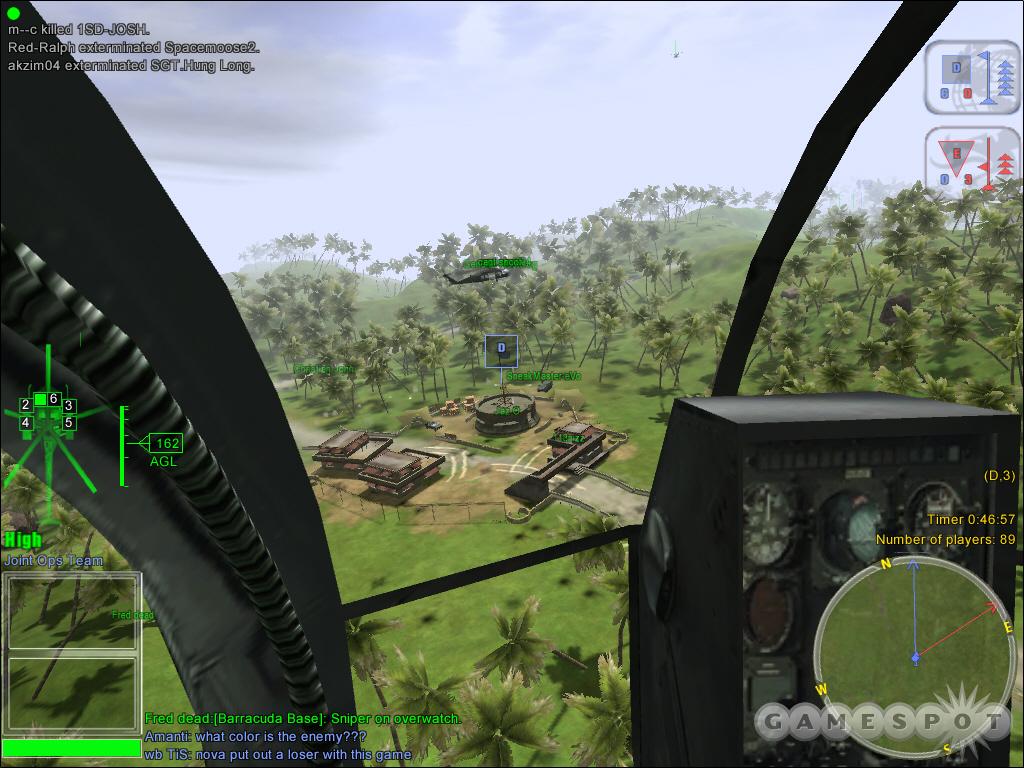
The fact that you can die so quickly makes it important that you approach Joint Operations differently than you would Battlefield 1942 or any other comparable games. Instead of rushing brashly forward, taking a few hits, and then calling for a medic, you have to hang back and scout your target from afar. There's a very strong predator/prey dynamic going on where you have to stalk your victims, kill them, and then fall back lest you fall victim yourself (tracer fire and the little directional fire indicator in the corner minimap can draw a straight line back to you). The most success we've had was when we slowed down and took our time.
Even so, it still seems far too easy to die in this game, and that can be a pain, especially if you're playing on some of the larger maps. You can spend a minute or two just getting to where the action is and then be cut down almost instantly. To soften this a bit, you can make use of forward spawn points, rather than using the default instant spawn point far to the rear, although it may require waiting about 30 to 45 seconds.
When you're not running around, you're riding around in the many vehicles in the game, which are all a blast. Ironically, most of the vehicles in Joint Ops are best used as transport and not as weapons platforms; the enhanced mobility allows you to transport teammates around the map quickly. It's fun to land the helicopter, watch as your teammates clamber aboard, and then insert them into a hot landing zone with gunfire all around. NovaLogic went for ease-of-play instead of realism, so the helicopters use the familiar WASD control scheme that makes them effortless to fly. And it's also fun to load up the hovercraft with a couple of armored personnel carriers and jeeps and then deliver them to a hostile shore, or you can participate in high-speed river runs aboard the zodiac watercraft, which lets you zip past enemy defenses and deliver a small squad behind enemy lines.
The graphics in the game are beautiful, not just because the game renders huge levels chock full of jungles, villages, rice paddies, mountains, hills, valleys, and more, but also because it captures all of the little things that manage to stand out. You'll note things like the lushness of the jungle grasses, the heat wash coming off helicopter engines, or the sheer spectacle of hanging out the door of an airborne Black Hawk helicopter watching huge firefights going on below. The sound, on the other hand, has its low points as well as its high points; vehicle sounds are excellent, but some of the assault rifles sound a bit tinny and almost muted. The horns on the jeeps are downright lame and sound almost toylike.
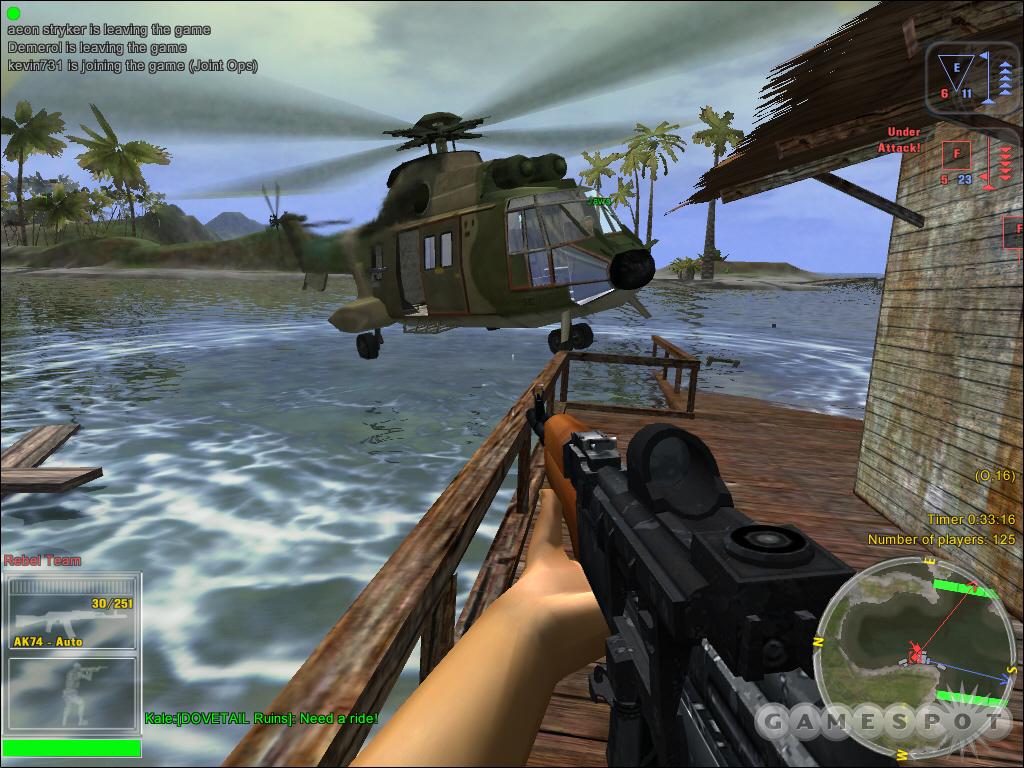
Meanwhile, the accelerated day/night cycle is an excellent feature because it changes the dynamics of the map in a natural way as the battle carries on. At night, it's harder to detect someone crouching in the tall grass, so you have to slow down and take your time. We've also seen instances of players flying strafing runs in the helicopter with the setting sun at their backs; anybody looking up to locate where the fire is coming from gets blinded by the sun. At night, there's usually enough moonlight to see without night-vision goggles most of the time, but it can still get fairly dark, necessitating the use of the goggles, which transform the darkness into an eerie green. It's cool to view combat at night, as the flash of muzzle fire and tracers are amplified through the goggles in a realistic way.
The level design in the game isn't particularly consistent. Some of the levels are well-designed and focused, but others feel a bit too big for their own good. There's an urban setting that's like the Mogadishu from Delta Force: Black Hawk Down, with lots of narrow streets and alleyways (it's fun to run around this environment with a buddy, covering one another as you bound ahead to the next street corner). Then there's the Dutch plantation map, a spread-out plain of rice paddies dominated by a giant hill in the middle, which is a perfect place for snipers to get a lay of the land. It's also a great spot for Stinger-armed engineers to swat the numerous helicopters flying by. On the other hand, there are maps that are a bit tedious to play. These maps include the Straights of Malacca, a gigantic, rectangular map consisting of islands strung out along a long chain. Even in a helicopter, traveling from island to island can take quite a while, and it takes even longer if you're in a slow-moving boat or hovercraft. Without a well-organized team with players working in concert with each other, these kinds of maps degenerate into a prolonged stalemate as neither side can get any momentum going.
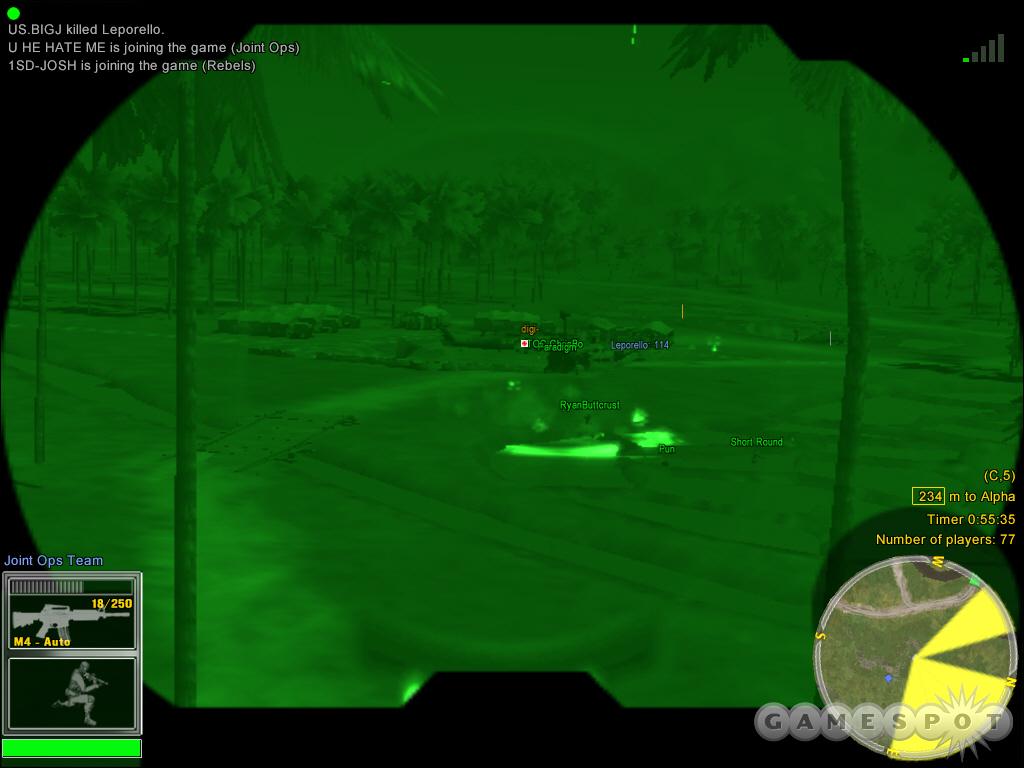
The game's sheer size is its greatest strength and weakness, as it guarantees that no one player can single-handedly change the balance of power between the two teams. While it's cool to feel like part of a huge battle with firefights going on in three or four places at once, it can also be a bit frustrating if your teammates can't, or won't, work together. Another of the downsides of having more than 100 players per server is that the odds are you'll pick those annoying teammates who purposely go out of their way to ruin everyone's time, such as by ramming their APCs into your helicopter as you're waiting to take off. There is a somewhat complicated system that allows players to punt offending players off the server, but the game could use a better, simpler, more prominent method. Meanwhile, all the elaborate commander controls that NovaLogic integrates into Joint Ops that allow players to direct the efforts of their team are useless unless the rest of the team plays ball.
Joint Operations plays smoothly at times, but there are moments when lag rears its ugly head. During those moments, vehicles tend to warp around and the gameplay becomes a bit jittery. Interestingly, the amount of lag doesn't seem to vary much between smaller games of 60 to 80 players to the largest games of 150, which suggests that the lag isn't a problem of scale and that it can be fixed. (Indeed, NovaLogic claims it has had beta tests of up to 250 players in a match.) The shipping version of the game also suffers from a number of bugs; you may lose your connection to a server or crash to the desktop every now and then. However, the worst bug has to do with Novaworld, NovaLogic's online matchmaking service, which makes it impossible to join a server under certain circumstances. NovaLogic is already working on a patch to address this and other issues. 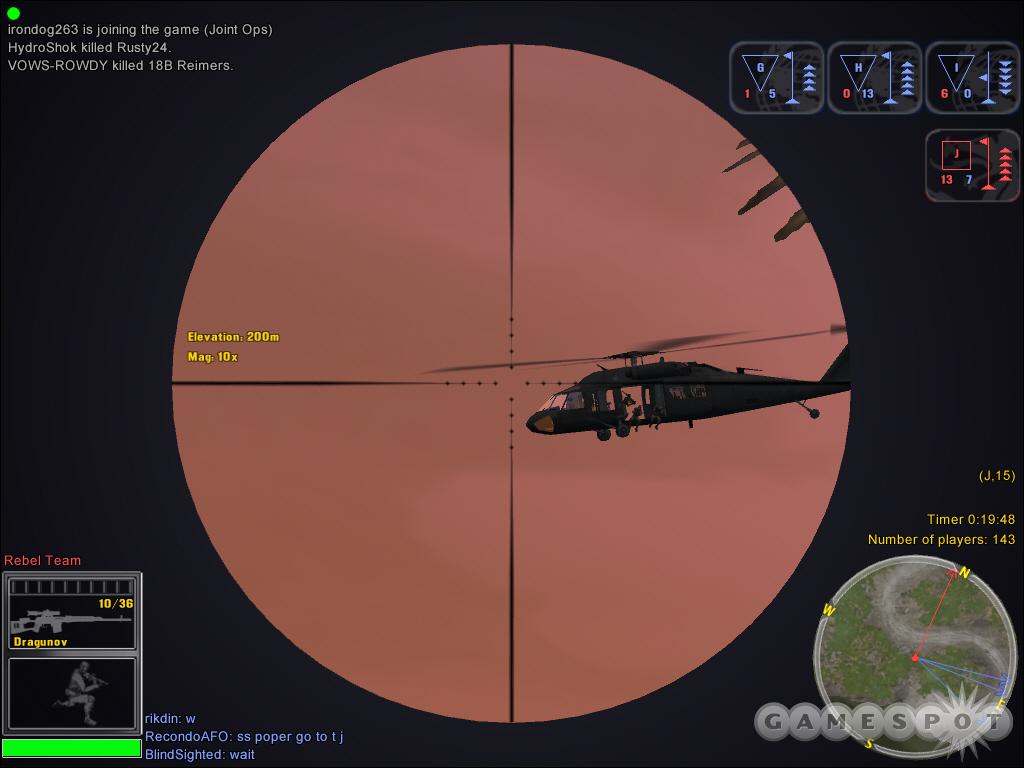
With that said, Joint Operations is already a great game with still more potential for improvement. When it really gets going, it's an exhilarating game of modern combat, albeit one that's also weighed down with some bugs and gameplay issues. For what it's worth, the same was true of Battlefield 1942 when it shipped, though that game's growing pains seem long forgotten by now. One can only hope that NovaLogic will follow suit by tweaking Joint Ops closer toward perfection.